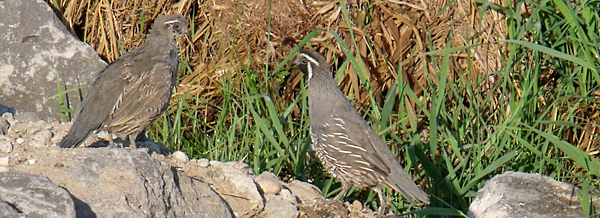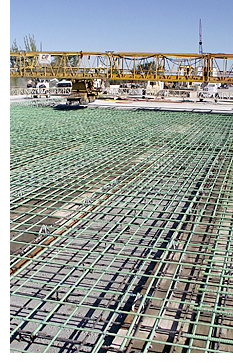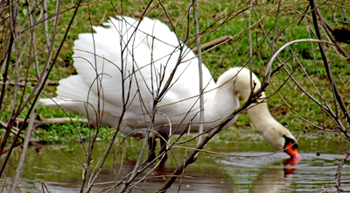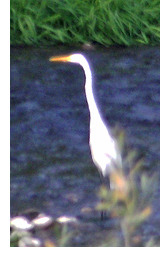

Birds and girders live in harmony
— Wildlife thriving in shadows of new Idaho 16 bridge —
It’s a mismatch that rivals The Odd Couple, but by all appearances seems to work without conflict. The great blue heron is about 4 feet tall and weighs in at a scant 6 pounds, or thereabouts.
The bridge is more than 1,700 feet long, 88 feet wide and tips the scales at 38 million pounds.
But The Little Guy – the pencil-legged heron -- does not compete with The Behemoth. In fact, the relationship is one of peaceful coexistence.
Even before the first shovel of dirt was turned for the bridge project, the effects to wildlife and the environment were carefully considered. The intent was to minimize construction impacts on resident birds and animals that call the Boise River home.
The large bridge spans the river near the junction of Idaho 16 and Idaho 44. Eventually – some time in the distant future – it will connect Emmett with Interstate 84.
 To avoid impacts to great blue heron courtship and nesting, vegetation removal and construction activities were prohibited within a 925-foot radius of any known or identified heron rookeries during spring and early summer.
To avoid impacts to great blue heron courtship and nesting, vegetation removal and construction activities were prohibited within a 925-foot radius of any known or identified heron rookeries during spring and early summer.
“The contract was very specific about staying out of the area during the blue heron and eagle nesting seasons when construction first started,” explained Dana Weiss, ITD project manager.
On a given day you’ll see blue heron, cattle egrets, turkey, falcons, hawks, redwing blackbirds and swallows near the bridge. Juvenile eagles thrive. Deer tracks abound.
A 2.5-mile extension of Idaho 16 is under way, connecting Chinden Boulevard (U.S. 20/26) to State Street (Idaho 44), including construction of the 1,726-foot-long, 11-span, 88-foot-wide bridge over the Boise River.
More than 1.5 million pounds of rebar and 36.6 million pounds of concrete will be used in the massive bridge. The $39 million bridge is funded by Grant Anticipation Revenue Vehicle bonds.
In addition to construction, GARVEE also funded the design and development of the route.
Although construction started just 15 months ago (May 2012), the environmental coordination began much earlier.
"Because of community and agency coordination and support for the project, the Environmental Impact Statement was completed in record time – just four years and three months, significantly faster than the national average for a project of this size and complexity," said ITD GARVEE Manager Amy Schroeder.
The bridge construction culminations years of preparation.
 ITD coordinated extensively with regulatory agencies, the public and land-use groups to determine values and work through concerns. To meet all environmental requirements for the sensitive river-crossing construction, ITD completed all needed documents and permits, including the Environmental Impact Statement and acquisition of permits along with permits for wetland mitigation, clean water, stream alteration and flood plain development.
ITD coordinated extensively with regulatory agencies, the public and land-use groups to determine values and work through concerns. To meet all environmental requirements for the sensitive river-crossing construction, ITD completed all needed documents and permits, including the Environmental Impact Statement and acquisition of permits along with permits for wetland mitigation, clean water, stream alteration and flood plain development.
A lot of work went toward honoring commitments made as the project moved from the design stage to construction, said ITD’s southwest Idaho environmental manager, Greg Vitley.
“Early and good coordination throughout the project keeps people informed and happy, and that rapport with stakeholders makes it easier to deal with any problems that might develop.”
“Avoiding and minimizing impacts was a big part of the coordination with resource agencies and other stakeholders as the project was being planned,” Vitley added.
Commitments were established in the contract language for the bridge project to help minimize impacts to the environment. Here is a short list of items that were addressed in the contract:
 WILDLIFE: Vegetation removal is minimized and restricted during specific periods to protect nesting season for migratory birds, which are included in the Migratory Bird Treaty Act. Great blue heron foraging habitat is located within the vicinity of the project.
WILDLIFE: Vegetation removal is minimized and restricted during specific periods to protect nesting season for migratory birds, which are included in the Migratory Bird Treaty Act. Great blue heron foraging habitat is located within the vicinity of the project.
AIR: The construction contractor must control air contaminants such as equipment emissions and dust that could harm crops, damage dwellings, or become a visibility nuisance. Actions addressed may include regularly spraying dusty areas with water, or covering trucks that are hauling dirt or debris in an open bed. The contractor also is required to promptly clean up spills of transported material on public roadways.
Wind fencing also is used to buffer wind velocities and minimize wind damage, such as soil erosion and snow drifting.
WATER QUALITY: Continuous monitoring of water quality during in-stream work ensures the project conforms to state water-quality standards.
FUEL: The restrictions require low-sulfur fuel to reduce both sulfur dioxide and particulate-matter emissions from engines.
RE-VEGETATE: Long-term soil stabilization is achieved by re-vegetating exposed areas with native plants when the areas are no longer needed for project construction.
CONTINUING COORDINATION WITH REGULATORY AGENCIES: Regular meetings with state and federal regulatory agencies keep regulators informed and help them address concerns quickly.
“With the bridge about halfway complete, the animals are alive and active in the area.
Animal life is thriving,” said Weiss.
Published 9-20-13